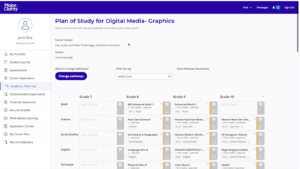Student Guidance for College and Career Readiness

By: Michael Dunn
As students matriculate through their P-12 educational journeys, assisting them in identifying and clarifying potential educational and career options has always been one of our greatest imperatives. As educators, we must be firmly committed to preparing our students well for the myriad opportunities from which they might choose, assuring they understand that there are many different paths to happiness and success.
Guidance to and for students in the 21st century is perhaps more important, and challenging, than it has ever been. The pace and breadth of change in the interconnected and technology-based world in which we exist is greater than at any time in our long history, and our mission must be that we help young people navigate that reality toward successful ends that fuel their personal interests and passions.
Assuring that students are college and career ready by the time they graduate is a discussion in every school district, school and legislative body in the nation. And it is a deeply important one. Yet, as a long time educator I would argue it is not a new discussion or commitment, even as its significance has likely increased as we become more clear about standards of learning necessary for future success.
Clarity about standards, and a commitment to assuring these standards render students college and career ready, are good things. My perspective, however, is these can also be dangerous things if defined too narrowly. I recently attended my youngest son’s college commencement and noted the great diversity of majors and degrees earned among the graduates. And I heard the university president tell the undergraduate degree earners that by earning a baccalaureate degree they had achieved “more education” that 70% of their fellow citizens. Thus, I worry that we sometimes define college and career ready as four-year college ready when, in fact, that is path is not everyone’s interest nor does every job or career necessitate a four-year degree.
Personally, I was not exposed to options that didn’t include earning a four-year degree. I was raised by parents who both had earned bachelor’s and master’s degrees and who worked in professional roles. Understandably, they encouraged a similar path for their children…and I am grateful they did. I am also appreciative they were in a financial position to send my brother and me to college. However, not every kid, or even most, grow up as I did with the inherent advantages I had.
So as I think about guidance owed to all the students with whom we work, I believe it is critical that we illuminate for them the many options and educational paths they might consider, and importantly that we help them figure out how to pay for the pursuit of those options without having to begin their chosen career with the burden of a mountain of debt. Analogously, I believe that in our classrooms we need to resist the incentive (driven by high stakes testing) that encourages educators to teach students the right answers, and instead assure we give due shrift to helping them learn how to ask the right questions.
By holding high standards for each student we serve, and matching those expectations with equally high and individualized levels of support; by exposing all students early in and throughout their P-12 experiences to the wide variety of opportunities and challenges that exist and lighting brightly the pathways to each; and by assuring we help them navigate how to access and afford whichever journey they choose, we can then take some comfort in in the quality and effectiveness of the guidance we have provided. That said, I also argue that we must accept and be understanding of the fact that not every student might know what she or he wants at age 18…and so the work we do to assure many doors are cracked and left open for them is perhaps our most important work of all.
To learn more about next generation advising, see the new Smart Series paper, “Getting Ready for College, Careers, and the Common Core.” To download the full paper and infographic, go to digitallearningnow.com/dln-smart-series or follow along on social media using the hashtags #SmartSeries, #CCR and #DigLN.
 Michael Dunn is the superintendent of NorthEast Washington Educational Service District 101, serving 59 public school districts and additional private schools in the state of Washington. Dunn is a 35-year education veteran whose professional background includes work as a teacher and administrator in districts of diverse size and setting. Prior to ESD101 he was superintendent of Cheney Public Schools in Spokane County. Prior to that, he worked five years as executive director of Northwest area schools for Spokane Public Schools, the state’s second-largest school district. Dunn holds a bachelor’s degree in political science, a master’s degree in educational administration, and a doctorate in educational leadership, all from Washington State University.
Michael Dunn is the superintendent of NorthEast Washington Educational Service District 101, serving 59 public school districts and additional private schools in the state of Washington. Dunn is a 35-year education veteran whose professional background includes work as a teacher and administrator in districts of diverse size and setting. Prior to ESD101 he was superintendent of Cheney Public Schools in Spokane County. Prior to that, he worked five years as executive director of Northwest area schools for Spokane Public Schools, the state’s second-largest school district. Dunn holds a bachelor’s degree in political science, a master’s degree in educational administration, and a doctorate in educational leadership, all from Washington State University.






0 Comments
Leave a Comment
Your email address will not be published. All fields are required.